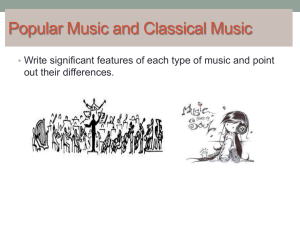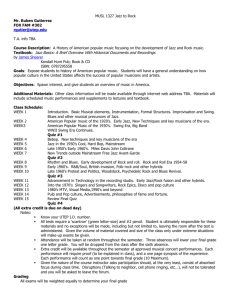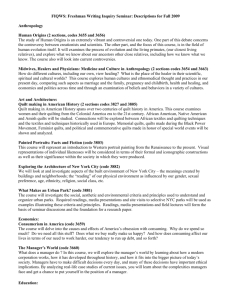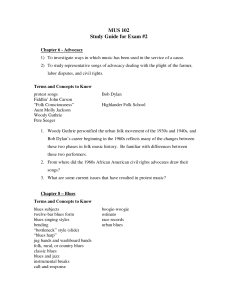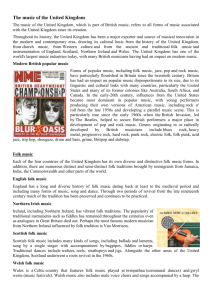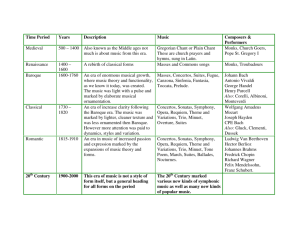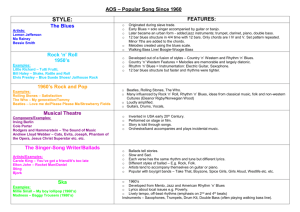Unit 16 American Popular Culture
advertisement
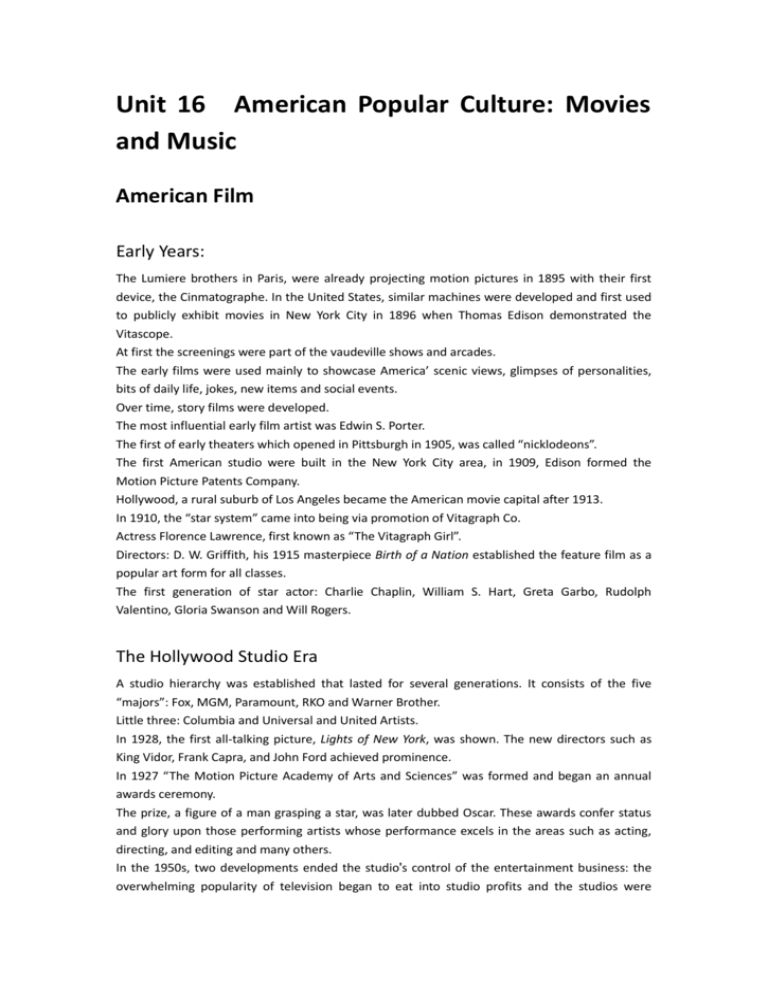
Unit 16 American Popular Culture: Movies and Music American Film Early Years: The Lumiere brothers in Paris, were already projecting motion pictures in 1895 with their first device, the Cinmatographe. In the United States, similar machines were developed and first used to publicly exhibit movies in New York City in 1896 when Thomas Edison demonstrated the Vitascope. At first the screenings were part of the vaudeville shows and arcades. The early films were used mainly to showcase America’ scenic views, glimpses of personalities, bits of daily life, jokes, new items and social events. Over time, story films were developed. The most influential early film artist was Edwin S. Porter. The first of early theaters which opened in Pittsburgh in 1905, was called “nicklodeons”. The first American studio were built in the New York City area, in 1909, Edison formed the Motion Picture Patents Company. Hollywood, a rural suburb of Los Angeles became the American movie capital after 1913. In 1910, the “star system” came into being via promotion of Vitagraph Co. Actress Florence Lawrence, first known as “The Vitagraph Girl”. Directors: D. W. Griffith, his 1915 masterpiece Birth of a Nation established the feature film as a popular art form for all classes. The first generation of star actor: Charlie Chaplin, William S. Hart, Greta Garbo, Rudolph Valentino, Gloria Swanson and Will Rogers. The Hollywood Studio Era A studio hierarchy was established that lasted for several generations. It consists of the five “majors”: Fox, MGM, Paramount, RKO and Warner Brother. Little three: Columbia and Universal and United Artists. In 1928, the first all-talking picture, Lights of New York, was shown. The new directors such as King Vidor, Frank Capra, and John Ford achieved prominence. In 1927 “The Motion Picture Academy of Arts and Sciences” was formed and began an annual awards ceremony. The prize, a figure of a man grasping a star, was later dubbed Oscar. These awards confer status and glory upon those performing artists whose performance excels in the areas such as acting, directing, and editing and many others. In the 1950s, two developments ended the studio's control of the entertainment business: the overwhelming popularity of television began to eat into studio profits and the studios were forced by Federal court rulings to abandon the control of distribution and exhibition that they had maintained through massive conglomerate corporations. Popular film star in 1950s and 1960s: Marlon Brando, Marilyn Monroe, and James Dean New genre films: horror, science fiction, and rock’n’ roll stories aimed at ten-agers proliferated. The principal stars of 1960s and 1970s: Jane Fonda, Barbra Streisand, Dustin Hoffman, and Woody Allen. Important American directors of the 1970s, 1980s, and 1990s include Peter Bogdanovich, Francis Ford Coppola, Robert Altman, and Martin Scorsese. The leading directors in the 1990s and the early 21st century: Steven Spielberg, George Lucas, and Jams Cameron. Special-effects films : Terminator 2, Judgment Day(1991), Jurassic Park(1993), and Titanic(1997). independent films: Steven Soderbergh’s Sex, and Videotape(1989) and Quentin Tarantino’s Reservoir Dogs(1992). During the late 1990s, DVDs became the new standard for consumer video, replacing VHS tapes. During the first decade of the 21st century, there has been an increasing globalization of US cinema: Crouching Tiger, Hidden Dragon(Chinese ), Spirited Away (Japanese), City of God( Portuguese), Slumdog Millionaire (Hindi and English ), and Inglourious Basterds( English, Gweman, and French) Recently there has been a revival in 3D film popularity the first being James Cameron’s Ghosts of the Abyss and most recently in December,2009 his Avatar, an epic science fiction, was re-leased in IMAX 3D format worldwide. American Popular Music since 1900 Distinctive styles of American popular music emerged early in the 19th century, and first five decades of the 20th century the American music industry developed a series of new forms of music, including country, R&B, jazz and hip hop, help to express an American national identity. The earliest songs that could be considered American popular music were sentimental parlor songs by Stephen Foster. By the early 20th century, the vaudeville and become a respected entertainment among the general public. After World War Ⅰ, Americans heard the music of King Oliver's Creole Jazz Band, and Louis Armstrong. The singing of Bessie Smith and Ma Rainey was preserved on so-called “race records”. Jazz is a kind of music characterized by blue notes, syncopation, swing, call and response, and improvisation. In the 1920s, the music performed by these artists was extremely popular with the public and was typically labeled as jazz. In the early 1940s, Charlie Parker, and others musicians developed a style called be-pop. Rock music, which is short for rock’n’roll, refers to the music that catered to a young audience, th e post-WWⅡ baby-boomers especially. Until the 1950s, American popular music was divided into three separate styles, each with its ow n performers, musical content, and audience. ① One style is called pop, and it served most Americans. ②the second style, “rhythm-and-blues, ’came from the blues sung by black performers along with the fast dance music that had grown out of ragtime and boogie-woogie. ③the third style is now called “ country-and-western,” but before World War Ⅱ it was often called “hillbilly” music. In 1951, Alan Freed began a regular program featuring rhythm-and blues music and the show bec ame an instant hit among local white teenagers. Between 1951 and 1954, the white adolescence fascination with rhythm-and blues became a na tionwide phenomenon. During and after World War Ⅱ, many black people moved to northern cities in search of jobs. T his led to an increase in the production of rhythm and blues records. Country-and-western music was also being more widely heard. In 1955, after an appearance on nationwide television, Elvis Presley’s singing--- a combination of rhythm and blues and country-and-western and his performing style came to mean “rock and roll ” all over the United States. By the early 1960s, rock had spread across the Atlantic to England, and new groups began to eme rge there as well. By 1964, when the Beatles were introduced to US audiences, they had revolutionize pop music. Today, songs like “Eleanor Rigby”, “In My Life” and “Help” are rock classics. The arrival of Bob Dylan in New York in the early 1960s, breathed new life into the folk music revival. From the mid-1960s numerous performers followed the footsteps of Dylan in the rock music scene. By the 1970s, emphasis had shifted away from the music industry toward the performers and composers. By the end of the 1980s, pop-rock largely used images derived from the British rock movement. The 1990s opened with an influx of Grunge music coming from Seattle. The rap music quickly caught on and boasted artists such as the Puff Daddy, and Tupac. Rap music has been black run and black created.
